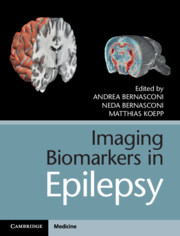Book contents
- Imaging Biomarkers in Epilepsy
- Imaging Biomarkers in Epilepsy
- Copyright page
- Dedication
- Contents
- Preface
- Contributors
- Part I Imaging the Development and Early Phase of the Disease
- Part II Modeling Epileptogenic Lesions and Mapping Networks
- Part III Predicting the Response to Therapeutic Interventions
- Chapter 13 Prevention of Epileptogenesis in Animal Models
- Chapter 14 Imaging Mechanisms of Drug Resistance in Experimental Models of Epilepsy
- Chapter 15 Biomarkers of Drug Response and Pharmacoresistance to Epilepsy
- Chapter 16 Predicting the Outcome of Surgical Interventions for Epilepsy Using Imaging Biomarkers
- Part IV Mapping Consequences of the Disease
- Index
- References
Chapter 13 - Prevention of Epileptogenesis in Animal Models
from Part III - Predicting the Response to Therapeutic Interventions
Published online by Cambridge University Press: 07 January 2019
- Imaging Biomarkers in Epilepsy
- Imaging Biomarkers in Epilepsy
- Copyright page
- Dedication
- Contents
- Preface
- Contributors
- Part I Imaging the Development and Early Phase of the Disease
- Part II Modeling Epileptogenic Lesions and Mapping Networks
- Part III Predicting the Response to Therapeutic Interventions
- Chapter 13 Prevention of Epileptogenesis in Animal Models
- Chapter 14 Imaging Mechanisms of Drug Resistance in Experimental Models of Epilepsy
- Chapter 15 Biomarkers of Drug Response and Pharmacoresistance to Epilepsy
- Chapter 16 Predicting the Outcome of Surgical Interventions for Epilepsy Using Imaging Biomarkers
- Part IV Mapping Consequences of the Disease
- Index
- References
- Type
- Chapter
- Information
- Imaging Biomarkers in Epilepsy , pp. 135 - 147Publisher: Cambridge University PressPrint publication year: 2019

